Abstract
Murine A strain (KkDdLd) sarcoma I (SaI) tumor cells have been transfected with a cloned H-2Kb gene. The resulting clones (SKB clones) stably express high levels of a molecule that is serologically and biochemically indistinguishable from the H-2Kb antigen. SKB clones are not susceptible to cytotoxic T lymphocyte-mediated lysis by H-2Kb-specific bulk, cloned, or H-2Kb-restricted lymphocytic choriomeningitis virus-specific effectors. Survival times of A/J and B10.A mice challenged i.p. with the H-2Kb-expressing transfectants and the parental SaI cells are similar, suggesting that the presence of an allogeneic major histocompatibility complex class I antigen on the surface of this tumor line is insufficient for tumor rejection.
Full text
PDF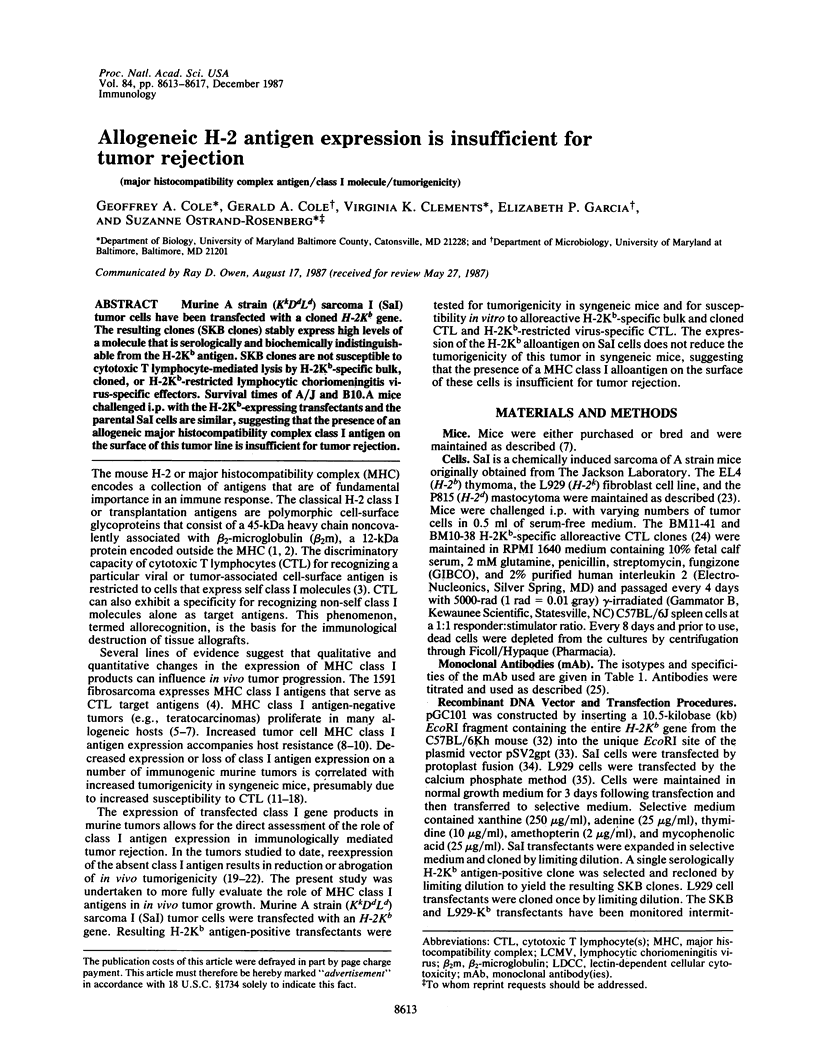
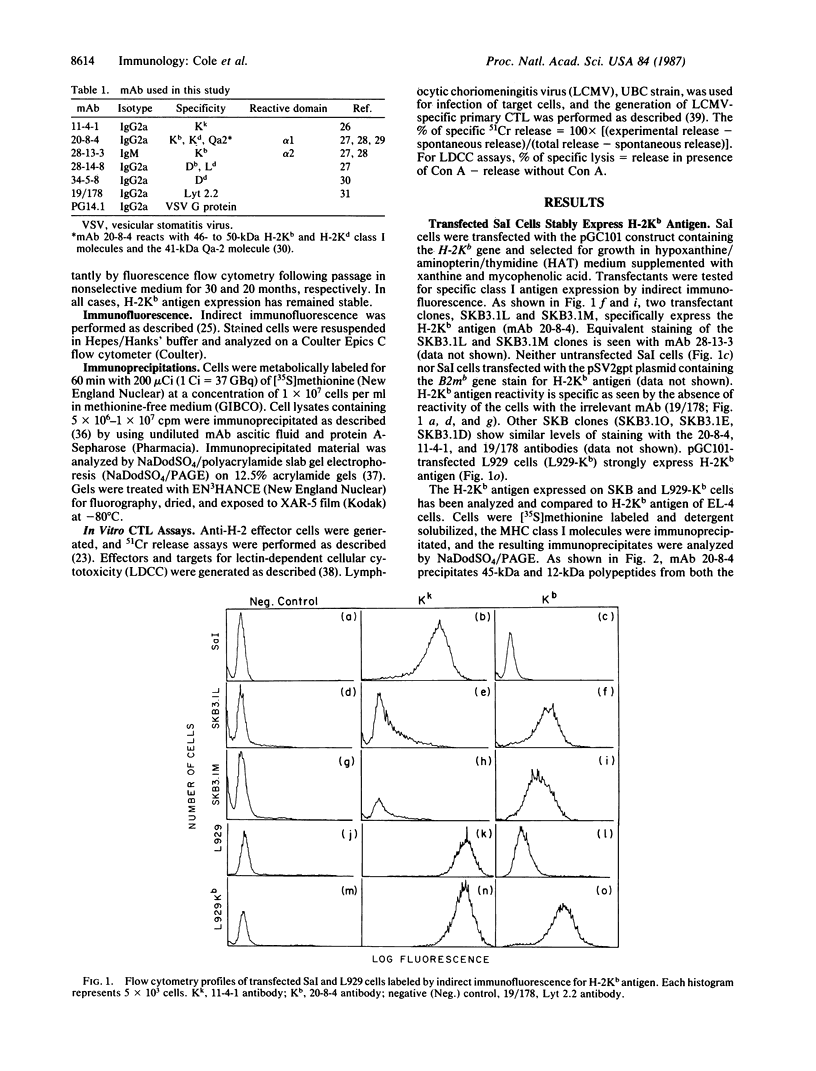
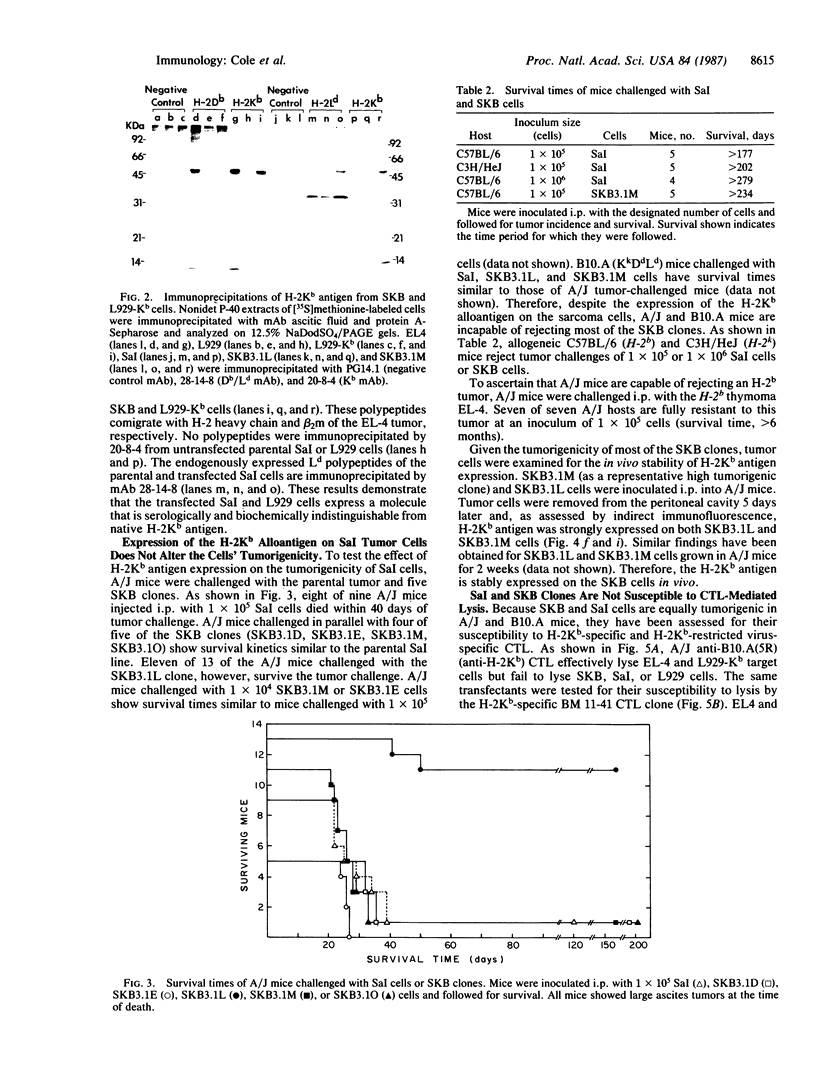
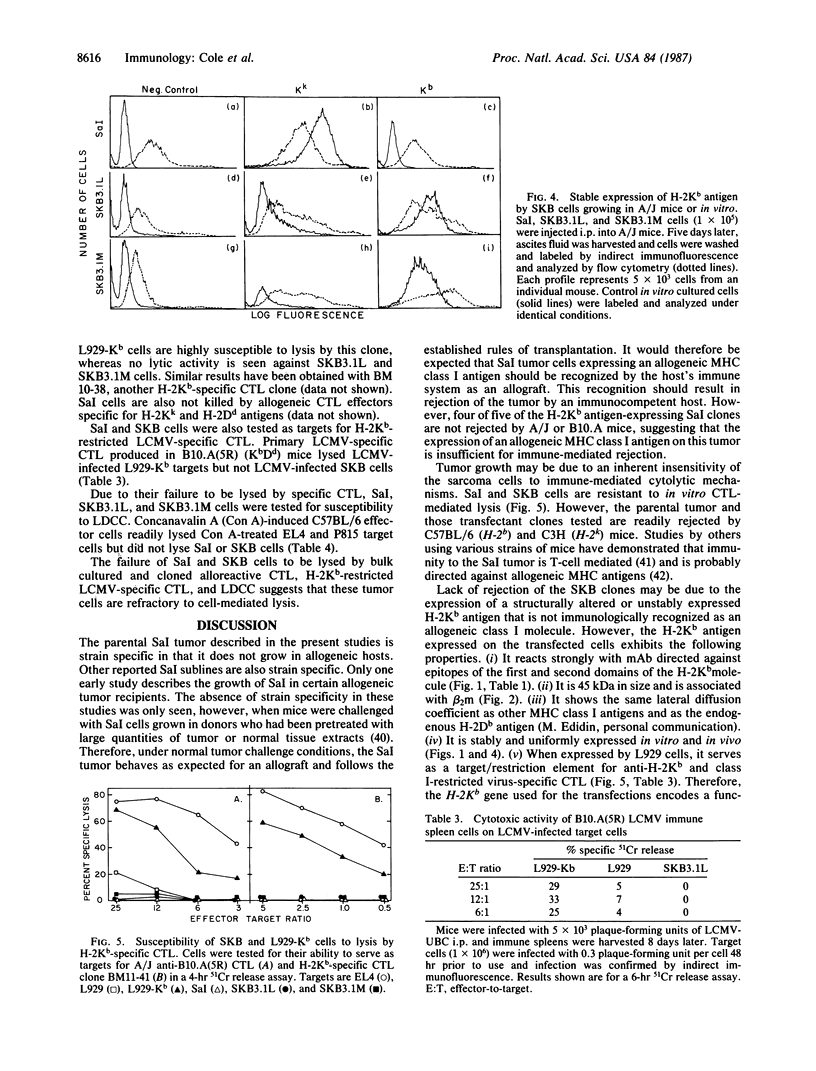
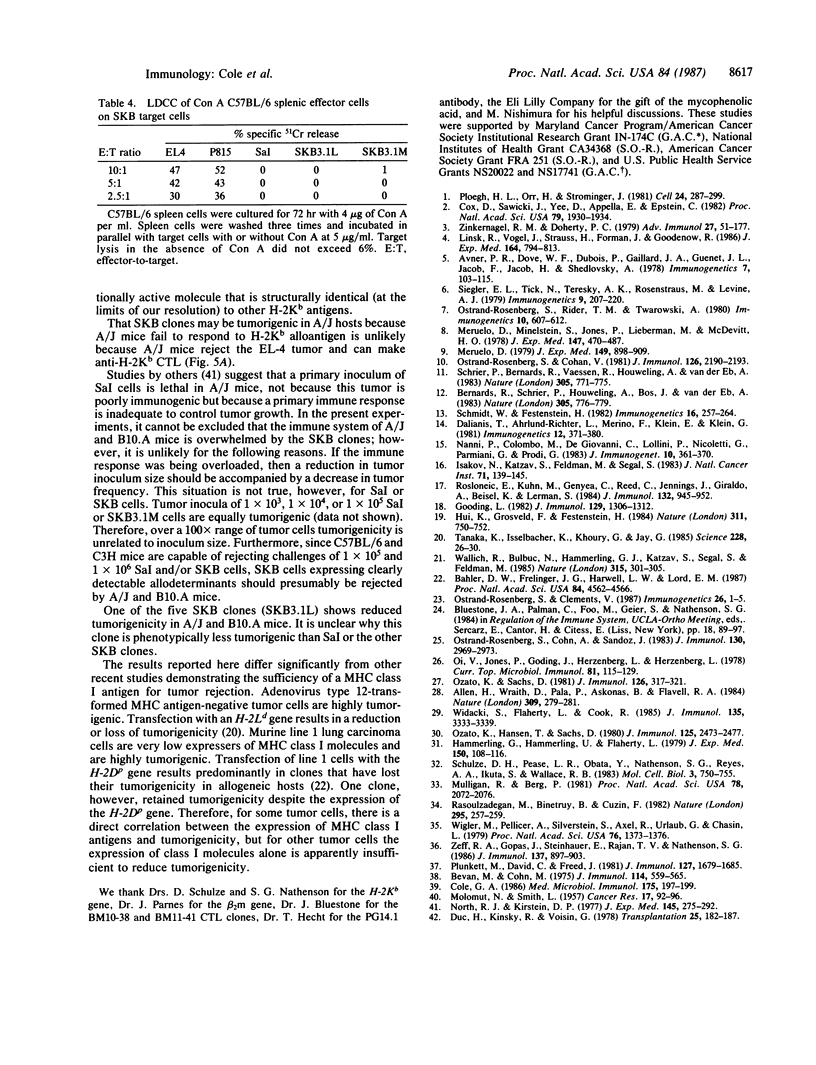
Images in this article
Selected References
These references are in PubMed. This may not be the complete list of references from this article.
- Allen H., Wraith D., Pala P., Askonas B., Flavell R. A. Domain interactions of H-2 class I antigens alter cytotoxic T-cell recognition sites. Nature. 1984 May 17;309(5965):279–281. doi: 10.1038/309279a0. [DOI] [PubMed] [Google Scholar]
- Bahler D. W., Frelinger J. G., Harwell L. W., Lord E. M. Reduced tumorigenicity of a spontaneous mouse lung carcinoma following H-2 gene transfection. Proc Natl Acad Sci U S A. 1987 Jul;84(13):4562–4566. doi: 10.1073/pnas.84.13.4562. [DOI] [PMC free article] [PubMed] [Google Scholar]
- Bernards R., Schrier P. I., Houweling A., Bos J. L., van der Eb A. J., Zijlstra M., Melief C. J. Tumorigenicity of cells transformed by adenovirus type 12 by evasion of T-cell immunity. 1983 Oct 27-Nov 2Nature. 305(5937):776–779. doi: 10.1038/305776a0. [DOI] [PubMed] [Google Scholar]
- Bevan M. J., Cohn M. Cytotoxic effects of antigen- and mitogen-induced T cells on various targets. J Immunol. 1975 Feb;114(2 Pt 1):559–565. [PubMed] [Google Scholar]
- Cole G. A. Production or prevention of neurologic disease by continuous lines of arenavirus-specific cytotoxic T lymphocytes. Med Microbiol Immunol. 1986;175(2-3):197–199. doi: 10.1007/BF02122450. [DOI] [PubMed] [Google Scholar]
- Cox D. R., Sawicki J. A., Yee D., Appella E., Epstein C. J. Assignment of the gene for beta 2-microglobulin (B2m) to mouse chromosome 2. Proc Natl Acad Sci U S A. 1982 Mar;79(6):1930–1934. doi: 10.1073/pnas.79.6.1930. [DOI] [PMC free article] [PubMed] [Google Scholar]
- Dalianis T., Ahrlund-Richter L., Merino F., Klein E., Klein G. Reduced humoral and cellular cytotoxic sensitivity in histocompatibility variants of the YAC (Moloney) lymphoma. Immunogenetics. 1981;12(3-4):371–380. doi: 10.1007/BF01561677. [DOI] [PubMed] [Google Scholar]
- Duc H. T., Kinsky R. G., Voisin G. A. Ia versus K/D antigens in immunological enhancement of tumor allografts. Transplantation. 1978 Apr;25(4):182–187. doi: 10.1097/00007890-197804000-00005. [DOI] [PubMed] [Google Scholar]
- Gooding L. R. Characterization of a progressive tumor from C3H fibroblasts transformed in vitro with SV40 virus. Immunoresistance in vivo correlates with phenotypic loss of H-2Kk. J Immunol. 1982 Sep;129(3):1306–1312. [PubMed] [Google Scholar]
- Hui K., Grosveld F., Festenstein H. Rejection of transplantable AKR leukaemia cells following MHC DNA-mediated cell transformation. Nature. 1984 Oct 25;311(5988):750–752. doi: 10.1038/311750a0. [DOI] [PubMed] [Google Scholar]
- Hämmerling G. J., Hämmerling U., Flaherty L. Qat-4 and Qat-5, new murine T-cell antigens governed by the Tla region and identified by monoclonal antibodies. J Exp Med. 1979 Jul 1;150(1):108–116. doi: 10.1084/jem.150.1.108. [DOI] [PMC free article] [PubMed] [Google Scholar]
- Isakov N., Katzav S., Feldman M., Segal S. Loss of expression of transplantation antigens encoded by the H-2K locus on Lewis lung carcinoma cells and its relevance to the tumor's metastatic properties. J Natl Cancer Inst. 1983 Jul;71(1):139–145. [PubMed] [Google Scholar]
- Linsk R., Vogel J., Stauss H., Forman J., Goodenow R. S. Structure and function of three novel MHC class I antigens derived from a C3H ultraviolet-induced fibrosarcoma. J Exp Med. 1986 Sep 1;164(3):794–813. doi: 10.1084/jem.164.3.794. [DOI] [PMC free article] [PubMed] [Google Scholar]
- MOLOMUT N., SMITH L. W. Host-induced alterations in strain specificity of sarcoma I in mice: effect of active immunization of the host. Cancer Res. 1957 Feb;17(2):92–96. [PubMed] [Google Scholar]
- Meruelo D. A role for elevated H-2 antigen expression in resistance to neoplasia caused by radiation-induced leukemia virus. Enhancement of effective tumor surveillance by killer lymphocytes. J Exp Med. 1979 Apr 1;149(4):898–909. doi: 10.1084/jem.149.4.898. [DOI] [PMC free article] [PubMed] [Google Scholar]
- Meruelo D., Nimelstein S. H., Jones P. P., Lieberman M., McDevitt H. O. Increased synthesis and expression of H-2 antigens on thymocytes as a result of radiation leukemia virus infection: a possible mechanism for H-2 linked control of virus-induced neoplasia. J Exp Med. 1978 Feb 1;147(2):470–487. doi: 10.1084/jem.147.2.470. [DOI] [PMC free article] [PubMed] [Google Scholar]
- Mulligan R. C., Berg P. Selection for animal cells that express the Escherichia coli gene coding for xanthine-guanine phosphoribosyltransferase. Proc Natl Acad Sci U S A. 1981 Apr;78(4):2072–2076. doi: 10.1073/pnas.78.4.2072. [DOI] [PMC free article] [PubMed] [Google Scholar]
- Nanni P., Colombo M. P., De Giovanni C., Lollini P. L., Nicoletti G., Parmiani G., Prodi G. Impaired H-2 expression in B16 melanoma variants. J Immunogenet. 1983 Oct;10(5):361–370. doi: 10.1111/j.1744-313x.1983.tb00348.x. [DOI] [PubMed] [Google Scholar]
- North R. J., Kirstein D. P. T-cell-mediated concomitant immunity to syngeneic tumors. I. Activated macrophages as the expressors of nonspecific immunity to unrelated tumors and bacterial parasites. J Exp Med. 1977 Feb 1;145(2):275–292. doi: 10.1084/jem.145.2.275. [DOI] [PMC free article] [PubMed] [Google Scholar]
- Oi V. T., Jones P. P., Goding J. W., Herzenberg L. A., Herzenberg L. A. Properties of monoclonal antibodies to mouse Ig allotypes, H-2, and Ia antigens. Curr Top Microbiol Immunol. 1978;81:115–120. doi: 10.1007/978-3-642-67448-8_18. [DOI] [PubMed] [Google Scholar]
- Ostrand-Rosenberg S., Clements V. Resistance to 402AX teratocarcinoma involves immunity to minor histocompatibility antigens. Immunogenetics. 1987;26(1-2):1–5. doi: 10.1007/BF00345447. [DOI] [PubMed] [Google Scholar]
- Ostrand-Rosenberg S., Cohan V. L. H-2 negative teratocarcinoma cells become H-2 positive when passaged in genetically resistant host mice. J Immunol. 1981 Jun;126(6):2190–2193. [PubMed] [Google Scholar]
- Ostrand-Rosenberg S., Cohn A. L., Sandoz J. W. Multiple splenic lymphoid cell subpopulations regulate H-2 antigen expression on teratocarcinoma cells in vivo. J Immunol. 1983 Jun;130(6):2969–2973. [PubMed] [Google Scholar]
- Ozato K., Hansen T. H., Sachs D. H. Monoclonal antibodies to mouse MHC antigens. II. Antibodies to the H-2Ld antigen, the products of a third polymorphic locus of the mouse major histocompatibility complex. J Immunol. 1980 Dec;125(6):2473–2477. [PubMed] [Google Scholar]
- Ozato K., Sachs D. H. Monoclonal antibodies to mouse MHC antigens. III. Hybridoma antibodies reacting to antigens of the H-2b haplotype reveal genetic control of isotype expression. J Immunol. 1981 Jan;126(1):317–321. [PubMed] [Google Scholar]
- Ploegh H. L., Orr H. T., Strominger J. L. Major histocompatibility antigens: the human (HLA-A, -B, -C) and murine (H-2K, H-2D) class I molecules. Cell. 1981 May;24(2):287–299. doi: 10.1016/0092-8674(81)90318-4. [DOI] [PubMed] [Google Scholar]
- Plunkett M. L., David C. S., Freed J. H. Biochemical evidence for trans complementation of structural genes in the expression of I-E antigens in F1 hybrids. J Immunol. 1981 Oct;127(4):1679–1685. [PubMed] [Google Scholar]
- Rassoulzadegan M., Binetruy B., Cuzin F. High frequency of gene transfer after fusion between bacteria and eukaryotic cells. Nature. 1982 Jan 21;295(5846):257–259. doi: 10.1038/295257a0. [DOI] [PubMed] [Google Scholar]
- Rosloniec E. F., Kuhn M. H., Genyea C. A., Reed A. H., Jennings J. J., Giraldo A. A., Beisel K. W., Lerman S. P. Aggressiveness of SJL/J lymphomas correlates with absence of H-2Ds antigens. J Immunol. 1984 Feb;132(2):945–952. [PubMed] [Google Scholar]
- Schmidt W., Festenstein H. Resistance to cell-mediated cytotoxicity is correlated with reduction of H-2K gene products in AKR leukemia. Immunogenetics. 1982;16(3):257–264. doi: 10.1007/BF00343314. [DOI] [PubMed] [Google Scholar]
- Schrier P. I., Bernards R., Vaessen R. T., Houweling A., van der Eb A. J. Expression of class I major histocompatibility antigens switched off by highly oncogenic adenovirus 12 in transformed rat cells. 1983 Oct 27-Nov 2Nature. 305(5937):771–775. doi: 10.1038/305771a0. [DOI] [PubMed] [Google Scholar]
- Schulze D. H., Pease L. R., Obata Y., Nathenson S. G., Reyes A. A., Ikuta S., Wallace R. B. Identification of the cloned gene for the murine transplantation antigen H-2Kb by hybridization with synthetic oligonucleotides. Mol Cell Biol. 1983 Apr;3(4):750–755. doi: 10.1128/mcb.3.4.750. [DOI] [PMC free article] [PubMed] [Google Scholar]
- Tanaka K., Isselbacher K. J., Khoury G., Jay G. Reversal of oncogenesis by the expression of a major histocompatibility complex class I gene. Science. 1985 Apr 5;228(4695):26–30. doi: 10.1126/science.3975631. [DOI] [PubMed] [Google Scholar]
- Wallich R., Bulbuc N., Hämmerling G. J., Katzav S., Segal S., Feldman M. Abrogation of metastatic properties of tumour cells by de novo expression of H-2K antigens following H-2 gene transfection. Nature. 1985 May 23;315(6017):301–305. doi: 10.1038/315301a0. [DOI] [PubMed] [Google Scholar]
- Widacki S. M., Flaherty L., Cook R. G. Biochemical characterization of the molecules reactive with Qa-6 antiserum and the monoclonal antibody 20-8-4: evidence for structural similarity with the Qa-2 molecule. J Immunol. 1985 Nov;135(5):3333–3339. [PubMed] [Google Scholar]
- Wigler M., Pellicer A., Silverstein S., Axel R., Urlaub G., Chasin L. DNA-mediated transfer of the adenine phosphoribosyltransferase locus into mammalian cells. Proc Natl Acad Sci U S A. 1979 Mar;76(3):1373–1376. doi: 10.1073/pnas.76.3.1373. [DOI] [PMC free article] [PubMed] [Google Scholar]
- Zeff R. A., Gopas J., Steinhauer E., Rajan T. V., Nathenson S. G. Analysis of somatic cell H-2 variants to define the structural requirements for class I antigen expression. J Immunol. 1986 Aug 1;137(3):897–903. [PubMed] [Google Scholar]
- Zinkernagel R. M., Doherty P. C. MHC-restricted cytotoxic T cells: studies on the biological role of polymorphic major transplantation antigens determining T-cell restriction-specificity, function, and responsiveness. Adv Immunol. 1979;27:51–177. doi: 10.1016/s0065-2776(08)60262-x. [DOI] [PubMed] [Google Scholar]



